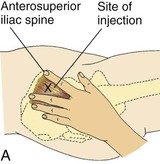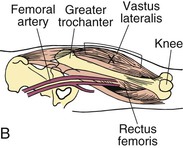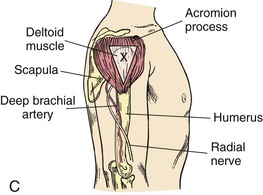Skill 34
Intramuscular Injections
The intramuscular (IM) injection route deposits medication into deep muscle tissue, which has a rich blood supply, allowing medication to absorb faster than with the subcutaneous route. However, there is an increased risk for injecting drugs directly into blood vessels. Any factor that interferes with local tissue blood flow affects the rate and extent of drug absorption.
Determine needle gauge by the medication to be administered. For example, administer immunizations and parenteral medications in aqueous solutions with a 20- to 25-gauge needle. Give viscous or oil-based solution with an 18- to 21-gauge needle. Use a small-gauge (22 to 25) needle for children. The current recommendations for needle length from the Centers for Disease Control and Prevention (2011a) are based on patient weight and body mass index (BMI). An adult patient who is thin requires a needle length of  to 1 inch, whereas an average patient requires a 1-inch needle; patients weighing more than 70 kg require a 1- to
to 1 inch, whereas an average patient requires a 1-inch needle; patients weighing more than 70 kg require a 1- to  -inch needle; and patients weighing more than 90 kg require a
-inch needle; and patients weighing more than 90 kg require a  -inch needle (CDC, 2011a). Evidence-based practice recommends needle lengths for adults based on site selection: vastus lateralis, 16 to 25 mm (
-inch needle (CDC, 2011a). Evidence-based practice recommends needle lengths for adults based on site selection: vastus lateralis, 16 to 25 mm ( to 1 inch); ventrogluteal, 38 mm (
to 1 inch); ventrogluteal, 38 mm ( inches); and deltoid, 25 to 38 mm (1 to
inches); and deltoid, 25 to 38 mm (1 to  inches) (Nicholl and Hesby, 2002). Recommendations for needle length include 25 mm (1 inch) for infants, 25 to 32 mm (1 to
inches) (Nicholl and Hesby, 2002). Recommendations for needle length include 25 mm (1 inch) for infants, 25 to 32 mm (1 to  inches) in toddlers, and 38 to 51 mm (
inches) in toddlers, and 38 to 51 mm ( to 2 inches) in older children (Hockenberry and Wilson, 2011). Preterm and small, emaciated infants may require a shorter needle based on weight and muscle mass. Obese children may require a longer needle up to 38 mm (
to 2 inches) in older children (Hockenberry and Wilson, 2011). Preterm and small, emaciated infants may require a shorter needle based on weight and muscle mass. Obese children may require a longer needle up to 38 mm ( inches) (Middleman et al., 2010). Based on the evidence, the recommendation for pediatric IM injection sites includes use of the anterolateral thigh for infants up to 12 months of age, deltoid in children 18 months and older, and ventrogluteal for children of all ages (Hockenberry and Wilson, 2011).
inches) (Middleman et al., 2010). Based on the evidence, the recommendation for pediatric IM injection sites includes use of the anterolateral thigh for infants up to 12 months of age, deltoid in children 18 months and older, and ventrogluteal for children of all ages (Hockenberry and Wilson, 2011).
When selecting an IM site, determine that the site is free of pain, infection, necrosis, bruising, and abrasions. Also consider the location of underlying bones, nerves, and blood vessels and the volume of medication you will administer. To locate the ventrogluteal muscle, place the heel of your hand over the greater trochanter of the patient’s hip with the wrist almost perpendicular to the femur. Use your right hand for the left hip, and your left hand for the right hip. Point the thumb toward the patient’s groin; point the index finger toward the anterior superior iliac spine; and extend the middle finger back along the iliac crest toward the buttock. The index finger, the middle finger, and the iliac crest form a V-shaped triangle. The injection site is the center of the triangle (Fig. 34-1, A).



Fig. 34-1 A, Anatomical site for ventrogluteal injection. B, Anatomical site for vastus lateralis injection. C, Anatomical site for deltoid injection.
Stay updated, free articles. Join our Telegram channel

Full access? Get Clinical Tree


